Efficient Multistep Algorithms for First-Order IVPs with Oscillating Solutions: II Implicit and Predictor–Corrector Algorithms
Abstract
1. Introduction
- Exponentially-fitted and Trigonometrically-Fitted Phase-Fitted and Amplification-Fitted Multistep Methods and Multistep Methods with minimal phase-lag (refer to [50,51,52,53,54,55,56,57,58,59,60,61,62,63,64,65,66,67,68,69,70,71,72,73,74,75,76,77,78,79,80,81,82,83,84,85,86,87,88,89,90,91,92,93,94,95,96,97,98,99,100,101,102,103,104,105,106,107,108,109,110,111,112,113,114]).
- Section 2 presents the general theory for calculating the phase-lag and amplification error of implicit multistep methods for first-order IVPs. In this section, we produce the direct formulae for the calculation of the phase-lag and amplification factor;
- Section 3 introduces the methodologies and the methods which that will be developed in Section 4, Section 5, Section 6, Section 7, Section 8, Section 9, Section 10, Section 11, Section 12, Section 13 and Section 14. In this section, we present the methodologies for the development of efficient multistep methods for first-order initial value problems;
- Section 4 introduces the Adams–Bashforth five-step method and presents the methodology for the minimization of the phase-lag. In this section, we present the explicit Adams–Bashforth five-step method and we study its phase-lag and amplification error.;
- Section 5 presents the development of the amplification-fitted Adams–Bashforth five-step method of fourth algebraic order with phase-lag of order four. Based on the theory developed in Section 2, we eliminate the amplification error and we calculate the coefficients of the method in order for the method to have phase-lag of order four;
- Section 6 presents the development of the amplification-fitted Adams–Bashforth five-step method of third algebraic order with phase-lag of order six. Based on the theory presented in Section 2, we eliminate the amplification error and we calculate the coefficients of the method in order for the method to have phase-lag of order six.
- Section 7 presents the development of the amplification-fitted Adams–Bashforth five-step method of fourth algebraic order. We calculate the coefficients of the method, in order for its amplification error to be equal to zero;
- Section 8 presents the development of the amplification-fitted and phase-fitted Adams–Bashforth five-step method of fourth algebraic order. We calculate the coefficients of the method, in order for its phase-lag and amplification error to be eliminated;
- Section 9 introduces the Adams–Moulton five-step method and presents the methodology for the minimization of the phase-lag. In this section, we present the implicit Adams–Moulton five-step method and we study its phase-lag and amplification error;
- Section 10 presents the development of the amplification-fitted Adams–Moulton five-step method of fifth algebraic order with phase-lag of order four. Based on the theory developed in Section 2, we eliminate the amplification error and we calculate the coefficients of the method in order for the method to have phase-lag of order four;
- Section 11 presents the development of the amplification-fitted Adams–Moulton five-step method of second algebraic order with phase-lag of order six. Based on the theory presented in Section 2, we vanish the amplification error and we calculate the coefficients of the method in order for the method to have phase-lag of order six;
- Section 12 presents the development of the amplification-fitted Adams–Moulton five-step method of second algebraic order with phase-lag of order eight. Based on the theory presented in Section 2, we demand the amplification error to be equal to zero and we calculate the coefficients of the method in order for the method to have phase-lag of order eight;
- Section 13 presents the development of the amplification-fitted Adams–Moulton five-step method of fifth algebraic order.We calculate the coefficients of the method, in order for its amplification error to be equal to zero;
- Section 14 presents the development of the amplification-fitted and phase-fitted Adams–Moulton five-step method of fifth algebraic order. We calculate the coefficients of the method, in order for its phase-lag and amplification error to be eliminated;
- Section 15 discusses a stability analysis for the newly proposed methods in Section 4, Section 5, Section 6, Section 7, Section 8, Section 9, Section 10, Section 11, Section 12, Section 13 and Section 14. We examine the stability of the developed methods for several values of v.
- Section 16 presents numerical results. We examine the efficiency of the proposed methods in their application on seven well-known problems. For each problem, we give conclusion for the behavior of the developed methods;
- Finally, Section 17 presents the conclusions of this research.
2. The Theory
- The Real Part
- The Imaginary Part
3. Procedures for the Methodologies for Achieving the Minimum Phase-Lag, Minimum Amplification Factor, Phase-Fitted, and Amplification-Fitted
- Procedures for the methodologies for achieving the minimum phase-lag;
- Procedures for the methodologies for achieving the minimum amplification factor;
- Procedures for the methodologies for achieving phase-fitted and amplification-fitted algorithms.
Methodologies for the Development of the Newly Introduced Methods
- Methods with minimization of the phase-lag (see Section 5, Section 6, Section 10, Section 11 and Section 12);
- Amplification-fitted methods (see Section 7 and Section 13);
- Phase-fitted and amplification-fitted methods (see Section 8 and Section 14).
4. Explicit Method: Adams–Bashforth Five-Step Method
4.1. Minimal Phase-Lag
Procedure to Minimize the Phase-Lag
- Eliminating the amplification factor;
- Phase-lag calculation using the coefficient acquired in the preceding stage;
- Expanding the phase-lag calculated before using a Taylor series;
- Defining the set of equations that minimizes the phase-lag;
- Calculation of the updated coefficients.
5. Amplification-Fitted Method of Fourth Algebraic Order with Phase-Lag of Order Four
5.1. Eliminating the Amplification Factor
5.2. Procedure for Minimizing the Phase-Lag
6. Amplification-Fitted Method of Third Algebraic Order with Phase-Lag of Order Six
7. Amplification-Fitted Method of Fourth Algebraic Order
7.1. Eliminating the Amplification Factor
Phase-Lag of the Method
8. Phase-Fitted and Amplification-Fitted Fourth Order Adams–Bashforth Method
9. Implicit Method: Adams–Moulton Five-Step Method
9.1. Minimal Phase-Lag
Procedure to Minimize the Phase-Lag
- Eliminating the amplification factor;
- Phase-lag calculation using the coefficient acquired in the preceding stage;
- Expanding the phase-lag calculated before using a Taylor series;
- Defining the set of equations that minimizes the phase-lag;
- Calculation of the updated coefficients.
10. Amplification-Fitted Adams–Moulton Five-Step Method of Fifth Algebraic Order with Phase-Lag of Order Four
11. Amplification-Fitted Adams–Moulton Five-Step Method of Second Algebraic Order with Phase-Lag of Order Six
12. Amplification-Fitted Adams–Moulton Five-Step Method of Second Algebraic Order with Phase-Lag of Order Eight
13. Amplification-Fitted Adams–Moulton Five-Step Method of Fifth Algebraic Order
13.1. Eliminating the Amplification Factor
Phase-Lag of the Method
14. Phase-Fitted and Amplification-Fitted Fifth Order Adams–Moulton Method
15. Stability Analysis
15.1. Adams–Bashforth Algorithm
15.2. Adams–Moulton Five-Step Algorithm
15.3. Stabilities of Adams–Bashforth and Adams–Moulton Algorithms
16. Numerical Results
16.1. Problem of Stiefel and Bettis
- The Runge–Kutta–Dormand–Prince fourth-order method [48], which is denoted as Numer. Algor. III;
- The Runge–Kutta–Dormand–Prince fifth-order method [48], which is denoted as Numer. Algor. IV;
- The Runge–Kutta–Fehlberg fourth-order method [117], which is denoted as Numer. Algor. V;
- The Runge–Kutta–Fehlberg fifth-order method [117], which is denoted as Numer. Algor. VI;
- The Runge–Kutta–Cash–Karp fifth-order method [118], which is denoted as Numer. Algor. VII;
- The amplification-fitted Adams–Bashforth–Moulton Algorithm of the second algebraic order with phase-lag of order six (Algorithms (37)–(A31)), which is denoted as Numer. Algor. IX;
- Numer. Algor. VII is more efficient than Numer. Algor. IV;
- Numer. Algor. V is more efficient than Numer. Algor. VII;
- Numer. Algor. VI is more efficient than Numer. Algor. V;
- Numer. Algor. III is more efficient than Numer. Algor. VI for the most step sizes but for small step sizes has approximately the same efficiency as Numer. Algor. VI;
- Numer. Algor. I is more efficient than Numer. Algor. VI;
- Numer. Algor. II and Numer. Algor. VIII are more efficient than Numer. Algor. I;
- Numer. Algor. IX has mixed behavior. For big step sizes, it has approximately the same efficiency as Numer. Algor. II and Numer. Algor. VIII. For middle step sizes, it is more efficient than Numer. Algor. III but less efficient than Numer. Algor. I. For small step sizes, it has approximately the same efficiency as Numer. Algor. II and Numer. Algor. VI;
- Numer. Algor. X has mixed behavior. For big step sizes, it is more efficient than Numer. Algor. II. For middle step sizes, it is more efficient than Numer. Algor. III but is less efficient than Numer. Algor. I. For small step sizes, it has approximately the same efficiency as Numer. Algor. III;
- Numer. Algor. XI gives the most efficient results.
16.2. Problem of Franco et al. [119]
- Numer. Algor. V is more efficient than Numer. Algor. IV;
- Numer. Algor. VII is more efficient than Numer. Algor. V;
- Numer. Algor. I is more efficient than Numer. Algor. VII;
- Numer. Algor. VIII is more efficient than Numer. Algor. I;
- Numer. Algor. VIII has approximately the same efficiency as Numer. Algor. VI, Numer. Algor. III, and Numer. Algor. II;
- Numer. Algor. IX is more efficient than Numer. Algor. VIII;
- Numer. Algor. X is more efficient than Numer. Algor. IX;
- Numer. Algor. XI gives the most efficient results.
16.3. Problem of Franco and Palacios [120]
- Numer. Algor. V is more efficient than Numer. Algor. IV;
- Numer. Algor. VII is more efficient than Numer. Algor. V;
- Numer. Algor. VI is more efficient than Numer. Algor. VII;
- Numer. Algor. VI has approximately the same efficiency as Numer. Algor. III;
- Numer. Algor. I is more efficient than Numer. Algor. VI;
- Numer. Algor. VIII is more efficient than Numer. Algor. II;
- Numer. Algor. IX is more efficient than Numer. Algor. VIII;
- Numer. Algor. X is more efficient than Numer. Algor. IX;
- Numer. Algor. XI gives the most efficient results.
16.4. A Nonlinear Orbital Problem [121]
- Numer. Algor. IV has approximately the same efficiency as Numer. Algor. V;
- Numer. Algor. VII is more efficient than Numer. Algor. V;
- Numer. Algor. VI is more efficient than Numer. Algor. VII;
- Numer. Algor. III has approximately the same efficiency as Numer. Algor. VI;
- Numer. Algor. I is more efficient than Numer. Algor. III;
- Numer. Algor. VIII is more efficient than Numer. Algor. I;
- Numer. Algor. II has approximately the same efficiency as Numer. Algor. VIII;
- Numer. Algor. IX is more efficient than Numer. Algor. VIII;
- Numer. Algor. X is more efficient than Numer. Algor. IX;
- Numer. Algor. XI gives the most efficient results.
16.5. Nonlinear Problem of Petzold [122]
- Numer. Algor. V is more efficient than Numer. Algor. IV;
- Numer. Algor. VII is more efficient than Numer. Algor. V;
- Numer. Algor. VI is more efficient than Numer. Algor. VII;
- Numer. Algor. III is more efficient than Numer. Algor. VI;
- Numer. Algor. I is more efficient than Numer. Algor. III;
- Numer. Algor. VIII is more efficient than Numer. Algor. I;
- Numer. Algor. II has approximately the same efficiency as Numer. Algor. VIII;
- Numer. Algor. IX has mixed behavior. For big step sizes, it is more efficient than Numer. Algor. VIII. For middle step sizes, it is more efficient than Numer. Algor. VI. For small step sizes, it is more efficient than Numer. Algor. VII;
- Numer. Algor. X has mixed behavior. For big step sizes, it is more efficient than Numer. Algor. VIII but less efficient than Numer. Algor. IX. For middle step sizes, it is more efficient than Numer. Algor. VII but less efficient than Numer. Algor. VI. For small step sizes, it is more efficient than Numer. Algor. VII;
- Numer. Algor. XI gives the most efficient results.
16.6. Two-Body Gravitational Problem
- Numer. Algor. I has approximately the same efficiency as Numer. Algor. VII;
- Numer. Algor. VI is more efficient than Numer. Algor. I;
- Numer. Algor. VIII is more efficient than Numer. Algor. VI;
- Numer. Algor. II has approximately the same efficiency as Numer. Algor. VIII, Numer. Algor. III, and Numer. Algor. V;
- Numer. Algor. IV is more efficient than Numer. Algor. II;
- Numer. Algor. IX is more efficient than Numer. Algor. IV;
- Numer. Algor. X is more efficient than Numer. Algor. IX;
- Numer. Algor. XI gives the most efficient results.
16.7. Perturbed Two-Body Gravitational Problem
16.7.1. Case
- Numer. Algor. I is more efficient than Numer. Algor. VII;
- Numer. Algor. I, Numer. Algor. II, Numer. Algor. V, Numer. Algor. VI, and Numer. Algor. VIII, have approximately the same efficiency;
- Numer. Algor. III is more efficient than Numer. Algor. I;
- Numer. Algor. IV is more efficient than Numer. Algor. III;
- Numer. Algor. IX is more efficient than Numer. Algor. IV;
- Numer. Algor. X is more efficient than Numer. Algor. IX;
- Numer. Algor. XI gives the most efficient results.
16.7.2. Case
- Numer. Algor. I is more efficient than Numer. Algor. VII;
- Numer. Algor. I, Numer. Algor. II, Numer. Algor. V, Numer. Algor. VI, and Numer. Algor. VIII, have approximately the same efficiency;
- Numer. Algor. III is more efficient than Numer. Algor. I;
- Numer. Algor. IV is more efficient than Numer. Algor. III;
- Numer. Algor. IX is more efficient than Numer. Algor. IV;
- Numer. Algor. X is more efficient than Numer. Algor. IX;
- Numer. Algor. XI gives the most efficient results.
- Results for all problems are most efficiently produced by the phase-fitted and amplification-fitted approach (Numer. Algor. XI);
- Results for the majority of problems are second-best when using the amplification-fitted Adams–Bashforth–Moulton Algorithm of second algebraic order with a phase-lag of order eight (Numer. Algor. X);
- Results for the majority of problems are third-best when using the amplification-fitted Adams–Bashforth–Moulton Algorithm of second algebraic order with a phase-lag of order six (Numer. Algor. IX).
- The strategy that disregards the algebraic order of the procedure in favor of minimizing the phase-lag;
- Strategies that concentrate on eliminating phase-lag and the amplification factor
17. Conclusions
- Strategies for reducing the phase-lag;
- A strategy for the construction of an amplification-fitted method;
- A strategy for the construction of a phase–fitted method.
- multistep methods for first-order initial-value problems with minimal phase-lag;
- phase-fitted and amplification-fitted multistep methods for first-order initial-value problems.
Funding
Data Availability Statement
Conflicts of Interest
Appendix A. Development of Algorithm III
- Eliminating the Amplification Factor
- Procedure for Minimizing the Phase-Lag
Appendix B. Development of Algorithm VII
- Eliminating the Amplification Factor
- Procedure for Minimizing the Phase-Lag
Appendix C. Development of Algorithm VIII
- Eliminating the Amplification Factor
- Procedure for Minimizing the Phase-Lag
Appendix D. Development of Algorithm IX
- Eliminating the Amplification Factor
- Procedure for Minimizing the Phase-Lag
References
- Landau, L.D.; Lifshitz, F.M. Quantum Mechanics; Pergamon: New York, NY, USA, 1965. [Google Scholar]
- Prigogine, I.; Rice, S. (Eds.) Advances in Chemical Physics Vol. 93: New Methods in Computational Quantum Mechanics; John Wiley & Sons: Hoboken, NJ, USA, 1997. [Google Scholar]
- Simos, T.E. Numerical Solution of Ordinary Differential Equations with Periodical Solution. Ph.D. Thesis, National Technical University of Athens, Athens, Greece, 1990. (In Greek). [Google Scholar]
- Raptis, A.D. Exponential multistep methods for ordinary differential equations. Bull. Greek Math. Soc. 1984, 25, 113–126. [Google Scholar]
- Vigo-Aguiar, J.; Ferrandiz, J.M. A general procedure for the adaptation of multistep algorithms to the integration of oscillatory problems. SIAM J. Numer. Anal. 1998, 35, 1684–1708. [Google Scholar] [CrossRef]
- Vigo-Aguiar, J. Mathematical Methods for the Numerical Propagation of Satellite Orbits. Ph.D. Thesis, University of Valladolid, Valladolid, Spain, 1993. (In Spanish). [Google Scholar]
- Ixaru, L.G. Numerical Methods for Differential Equations and Applications; Reidel: Dordrecht, The Netherlands; Boston, MA, USA; Lancaster, UK, 1984. [Google Scholar]
- Quinlan, G.D.; Tremaine, S. Symmetric multistep methods for the numerical integration of planetary orbits. Astron. J. 1990, 100, 1694–1700. [Google Scholar] [CrossRef]
- Lyche, T. Chebyshevian multistep methods for ordinary differential equations. Numer. Math. 1972, 10, 65–75. [Google Scholar] [CrossRef]
- Raptis, A.D.; Allison, A.C. Exponential-fitting methods for the numerical solution of the Schrödinger equation. Comput. Phys. Commun. 1978, 14, 1–5. [Google Scholar] [CrossRef]
- Konguetsof, A.; Simos, T.E. On the construction of Exponentially-Fitted Methods for the Numerical Solution of the Schrödinger Equation. J. Comput. Math. Sci. Eng. 2001, 1, 143–165. [Google Scholar] [CrossRef]
- Simos, T.E. Atomic Structure Computations in Chemical Modelling: Applications and Theory; Hinchliffe, A., Ed.; The Royal Society of Chemistry: London, UK, 2000; pp. 38–142. [Google Scholar]
- Simos, T.E.; Vigo-Aguiar, J. On the construction of efficient methods for second order IVPs with oscillating solution. Int. J. Mod. Phys. C 2001, 10, 1453–1476. [Google Scholar] [CrossRef]
- Dormand, J.R.; El-Mikkawy, M.E.A.; Prince, P.J. Families of Runge–Kutta-Nyström formulae. IMA J. Numer. Anal. 1987, 7, 235–250. [Google Scholar] [CrossRef]
- Van De Vyver, H. A Symplectic Exponentially Fitted Modified Runge–Kutta-Nyström Method for the Numerical Integration of Orbital Problems. New Astron. 2005, 10, 261–269. [Google Scholar] [CrossRef]
- Van De Vyver, H. On the Generation of P-Stable Exponentially Fitted Runge–Kutta-Nyström Methods By Exponentially Fitted Runge–Kutta Methods. J. Comput. Appl. Math. 2006, 188, 309–318. [Google Scholar] [CrossRef]
- Franco, J.M.; Khiar, Y.; Rández, L. Two new embedded pairs of explicit Runge–Kutta Methods adapted to the numerical solution of oscillatory problems. Appl. Math. Comput. 2015, 252, 45–57. [Google Scholar] [CrossRef]
- Franco, J.M.; Gomez, I. Symplectic explicit Methods of Runge–Kutta-Nyström type for solving perturbed oscillators. J. Comput. Appl. Math. 2014, 260, 482–493. [Google Scholar] [CrossRef]
- Franco, J.M.; Gomez, I. Some procedures for the construction of high-order exponentially fitted Runge–Kutta-Nyström Methods of explicit type. Comput. Phys. Commun. 2013, 184, 1310–1321. [Google Scholar] [CrossRef]
- Calvo, M.; Franco, J.M.; Montijano, J.I.; Rández, L. On some new low storage implementations of time advancing Runge–Kutta Methods. J. Comput. Appl. Math. 2012, 236, 3665–3675. [Google Scholar] [CrossRef]
- Calvo, M.; Franco, J.M.; Montijano, J.I.; Rández, L. Symmetric and symplectic exponentially fitted Runge–Kutta Methods of high order. Comput. Phys. Commun. 2010, 181, 2044–2056. [Google Scholar] [CrossRef]
- Calvo, M.; Franco, J.M.; Montijano, J.I.; Rández, L. On high order symmetric and symplectic trigonometrically fitted Runge–Kutta Methods with an even number of stages. BIT Numer. Math. 2010, 50, 3–21. [Google Scholar] [CrossRef]
- Franco, J.M.; Gomez, I. Accuracy and linear Stability of RKN Methods for solving second-order stiff problems. Appl. Numer. Math. 2009, 59, 959–975. [Google Scholar] [CrossRef]
- Calvo, M.; Franco, J.M.; Montijano, J.I.; Rández, L. Sixth-order symmetric and symplectic exponentially fitted Runge–Kutta Methods of the Gauss type. J. Comput. Appl. Math. 2009, 22, 387–398. [Google Scholar] [CrossRef]
- Calvo, M.; Franco, J.M.; Montijano, J.I.; Rández, L. Structure preservation of exponentially fitted Runge–Kutta Methods. J. Comput. Appl. Math. 2008, 218, 421–434. [Google Scholar] [CrossRef]
- Calvo, M.; Franco, J.M.; Montijano, J.I.; Rández, L. Sixth-order symmetric and symplectic exponentially fitted modified Runge–Kutta Methods of Gauss type. Comput. Phys. Commun. 2008, 178, 732–744. [Google Scholar] [CrossRef]
- Franco, J.M. Exponentially fitted symplectic integrators of RKN type for solving oscillatory problems. Comput. Phys. Commun. 2007, 177, 479–492. [Google Scholar] [CrossRef]
- Franco, J.M. New Methods for oscillatory systems based on ARKN Methods. Appl. Numer. Math. 2006, 56, 1040–1105. [Google Scholar] [CrossRef]
- Franco, J.M. Runge–Kutta-Nyström Methods adapted to the numerical integration of perturbed oscillators. Comput. Phys. Commun. 2002, 147, 770–787. [Google Scholar] [CrossRef]
- Franco, J.M. Stability of explicit ARKN Methods for perturbed oscillators. J. Comput. Appl. Math. 2005, 173, 389–396. [Google Scholar] [CrossRef]
- Wu, X.Y.; You, X.; Li, J.Y. Note on derivation of order conditions for ARKN Methods for perturbed oscillators. Comput. Phys. Commun. 2009, 180, 1545–1549. [Google Scholar] [CrossRef]
- Tocino, A.; Vigo-Aguiar, J. Symplectic conditions for exponential fitting Runge–Kutta-Nyström Methods. Math. Comput. Modell. 2005, 42, 873–876. [Google Scholar] [CrossRef]
- Van de Vyver, H. Comparison of some special optimized fourth-order Runge–Kutta Methods for the numerical solution of the Schrödinger equation. Comput. Phys. Commun. 2005, 166, 109–122. [Google Scholar] [CrossRef]
- Van de Vyver, H. Frequency evaluation for exponentially fitted Runge–Kutta Methods. J. Comput. Appl. Math. 2005, 184, 442–463. [Google Scholar] [CrossRef]
- Vigo-Aguiar, J.; Martín-Vaquero, J.; Ramos, H. Exponential fitting BDF-Runge–Kutta Algorithms. Comput. Phys. Commun. 2008, 178, 15–34. [Google Scholar] [CrossRef]
- Demba, M.A.; Senu, N.; Ramos, H.; Kumam, P.; Watthayu, W. A Phase– and Amplification–Fitted 5(4) Diagonally Implicit Runge–Kutta–Nyström Pair for Oscillatory Systems. Bull. Iran. Math. Soc. 2023, 49, 24. [Google Scholar] [CrossRef]
- Demba, M.A.; Ramos, H.; Watthayu, W.; Ahmed, I. A New Phase- and Amplification-Fitted Sixth-Order Explicit RKN Method to Solve Oscillating Systems. Thai J. Math. 2023, 21, 219–236. [Google Scholar]
- Monovasilis, T.; Kalogiratou, Z. High Order Two-Derivative Runge–Kutta Methods with Optimized Dispersion and Dissipation Error. Mathematics 2021, 9, 232. [Google Scholar] [CrossRef]
- Ahmad, N.A.; Senu, N.; Ibrahim, Z.B.; Othman, M.; Ismail, Z. Higher Order Three Derivative Runge–Kutta Method with Phase–Fitting and Amplification–Fitting Technique for Periodic IVPs. Malaysian J. Math. Sci. 2020, 14, 403–418. [Google Scholar]
- Lee, K.; Alias, M.A.; Senu, N.; Ahmadian, A. On efficient frequency-dependent parameters of explicit two-derivative improved Runge–Kutta-Nyström method with application to two-body problem. Alex. Eng. J. 2023, 72, 605–620. [Google Scholar] [CrossRef]
- Chien, L.K.; Senu, N.; Ahmadian, A.; Ibrahim, S.N.I. Efficient Frequency-Dependent Coefficients of Explicit Improved Two-Derivative Runge–Kutta Type Methods for Solving Third- Order IVPs. Pertanika J. Sci. Technol. 2023, 31, 843–873. [Google Scholar] [CrossRef]
- Demba, M.A.; Ramos, H.; Kumam, P.; Watthayu, W.; Senu, N.; Ahmed, I. A trigonometrically adapted 6(4) explicit Runge–Kutta-Nyström pair to solve oscillating systems. Math. Methods Appl. Sci. 2023, 46, 560–578. [Google Scholar] [CrossRef]
- Chen, B.Z.; Zhai, W.J. Optimal three-stage implicit exponentially-fitted RKN methods for solving second-order ODEs. Calcolo 2022, 59, 14. [Google Scholar] [CrossRef]
- Senu, N.; Ahmad, N.A.; Othman, M.; Ibrahim, Z.B. Numerical study for periodical delay differential equations using Runge–Kutta with trigonometric interpolation. Comput. Appl. Math. 2022, 41, 25. [Google Scholar] [CrossRef]
- Zhai, W.J.; Fu, S.H.; Zhou, T.C.; Xiu, C. Exponentially-fitted and trigonometrically-fitted implicit RKN methods for solving y′′=f(t,y). J. Appl. Math. Comput. 2022, 68, 1449–1466. [Google Scholar] [CrossRef]
- Senu, N.; Lee, K.C.; Ismail, W.F.W.; Ahmadian, A.; Ibrahim, S.N.I.; Laham, M. Improved Runge–Kutta Method with Trigonometrically-Fitting Technique for Solving Oscillatory Problem. Malaysian J. Math. Sci. 2021, 15, 253–266. [Google Scholar]
- Fang, Y.L.; Yang, Y.P.; You, X. An explicit trigonometrically fitted Runge–Kutta method for stiff and oscillatory problems with two frequencies. Int. J. Comput. Math. 2020, 97, 85–94. [Google Scholar] [CrossRef]
- Dormand, J.R.; Prince, P.J. A family of embedded Runge–Kutta formulae. J. Comput. Appl. Math. 1980, 6, 19–26. [Google Scholar] [CrossRef]
- Kalogiratou, Z.; Monovasilis, T.; Psihoyios, G.; Simos, T.E. Runge–Kutta type methods with special properties for the numerical integration of ordinary differential equations. Phys. Rep. 2014, 536, 75–146. [Google Scholar] [CrossRef]
- Shokri, A.; Khalsaraei, M.M. A new family of explicit linear two-step singularly P-stable Obrechkoff methods for the numerical solution of second-order IVPs. Appl. Math. Comput. 2020, 376, 125116. [Google Scholar] [CrossRef]
- Abdulganiy, R.I.; Ramos, H.; Okunuga, S.A.; Majid, Z.A. A trigonometrically fitted intra-step block Falkner method for the direct integration of second-order delay differential equations with oscillatory solutions. Afr. Mat. 2023, 34, 36. [Google Scholar] [CrossRef]
- Salih, M.M.; Ismail, F. Trigonometrically-Fitted Fifth Order Four-Step Predictor-Corrector Method for Solving Linear Ordinary Differential Equations with Oscillatory Solutions. Malaysian J. Math. Sci. 2022, 16, 739–748. [Google Scholar] [CrossRef]
- Godwin, O.J.; Adewale, O.S.; Otuwatomi, O.P. An efficient block solver of trigonometrically fitted method for stiff odes. Adv. Differ. Equ. Control Process. 2022, 28, 73–98. [Google Scholar] [CrossRef]
- Lee, K.C.; Senu, N.; Ahmadian, A.; Ibrahim, S.N.I. High-order exponentially fitted and trigonometrically fitted explicit two-derivative Runge–Kutta-type methods for solving third-order oscillatory problems. Math. Sci. 2022, 16, 281–297. [Google Scholar] [CrossRef]
- Obaidat, S.; Butt, R. A new implicit symmetric method of sixth algebraic order with vanished phase-lag and its first derivative for solving Schrodinger’s equation. Open Math. 2021, 19, 225–237. [Google Scholar] [CrossRef]
- Shokri, A.; Neta, B.; Khalsaraei, M.M.; Rashidi, M.M.; Mohammad-Sedighi, H. A Singularly P-Stable Multi-Derivative Predictor Method for the Numerical Solution of Second-Order Ordinary Differential Equations. Mathematics 2021, 9, 806. [Google Scholar] [CrossRef]
- Fang, Y.L.; Huang, T.; You, X.; Zheng, J.; Wang, B. Two-frequency trigonometrically-fitted and symmetric linear multi-step methods for second-order oscillators. J. Comput. Appl. Math. 2021, 392, 113312. [Google Scholar] [CrossRef]
- Chun, C.; Neta, B. Trigonometrically-Fitted Methods: A Review. Mathematics 2019, 7, 1197. [Google Scholar] [CrossRef]
- Anastassi, Z.A.; Simos, T.E. Numerical multistep methods for the efficient solution of quantum mechanics and related problems. Phys. Rep. 2009, 482–483, 1–240. [Google Scholar] [CrossRef]
- Chawla, M.M.; Rao, P.S. A Noumerov-Type Method with Minimal Phase–Lag for the Integration of 2nd Order Periodic Initial-Value Problems. J. Comput. Appl. Math. 1984, 11, 277–281. [Google Scholar] [CrossRef]
- Thomas, R.M. Phase properties of high order almost P-stable formulae. BIT 1984, 24, 225–238. [Google Scholar]
- Chawla, M.M.; Rao, P.S.; Neta, B. 2-Step 4Th-Order P-Stable Methods with Phase–Lag of Order 6 for Y″ = F(T,Y). J. Comput. Appl. Math. 1986, 16, 233–236. [Google Scholar] [CrossRef]
- Chawla, M.M.; Rao, P.S. An Explicit 6Th-Order Method with Phase–Lag of Order 8 for Y″ = F(T, Y). J. Comput. Appl. Math. 1987, 17, 365–368. [Google Scholar]
- JColeman, J.P. Numerical-Methods for Y″ = F(X,Y) Via Rational-Approximations for the Cosine. IMA J. Numer. Anal. 1989, 9, 145–165. [Google Scholar]
- Coleman, J.P.; Ixaru, L.G. P-Stability and Exponential-Fitting Methods for Y″ = F(X, Y). IMA J. Numer. Anal. 1996, 16, 179–199. [Google Scholar] [CrossRef]
- Coleman, J.P.; Duxbury, S.C. Mixed Collocation Methods for Y” = F(X,Y). J. Comput. Appl. Math. 2000, 126, 47–75. [Google Scholar] [CrossRef]
- Ixaru, L.G.; Berceanu, S. Coleman Method Maximally Adapted to the Schrödinger-Equation. Comput. Phys. Commun. 1987, 44, 11–20. [Google Scholar] [CrossRef]
- Ixaru, L.G.; Rizea, M. Numerov Method Maximally Adapted to the Schrödinger-Equation. J. Comput. Phys. 1987, 73, 306–324. [Google Scholar] [CrossRef]
- Ixaru, L.G.; Vanden Berghe, G.; De Meyer, H.; Van Daele, M. Four-Step Exponential-Fitted Methods for Nonlinear Physical Problems. Comput. Phys. Commun. 1997, 100, 56–70. [Google Scholar] [CrossRef]
- Ixaru, L.G.; Rizea, M. Four Step Methods for Y″ = F(X,Y). J. Comput. Appl. Math. 1997, 79, 87–99. [Google Scholar] [CrossRef]
- Van Daele, M.; Vanden Berghe, G.; De Meyer, H.; Ixaru, L.G. Exponential-Fitted Four-Step Methods for Y” = F(X,Y). Int. J. Comput. Math. 1998, 66, 299–309. [Google Scholar] [CrossRef]
- Ixaru, L.G.; Paternoster, B. A Conditionally P-Stable Fourth-Order Exponential-Fitting Method for Y” = F(X, Y). J. Comput. Appl. Math. 1999, 106, 87–98. [Google Scholar] [CrossRef]
- Ixaru, L.G. Numerical operations on oscillatory functions. Comput. Chem. 2001, 25, 39–53. [Google Scholar] [CrossRef] [PubMed]
- Ixaru, L.G.; Vanden Berghe, G.; De Meyer, H. Exponentially Fitted Variable Two-Step BDF Algorithm for First Order Odes. Comput. Phys. Commun. 2003, 150, 116–128. [Google Scholar] [CrossRef]
- Ixaru, L.G.; Rizea, M. Comparison of some four-Step Methods for the numerical solution of the Schrödinger equation. Comput. Phys. Commun. 1985, 38, 329–337. [Google Scholar] [CrossRef]
- Ixaru, L.G.; Rizea, M. A Numerov-like scheme for the numerical solution of the Schrödinger equation in the deep continuum spectrum of energies. Comput. Phys. Commun. 1980, 19, 23–27. [Google Scholar] [CrossRef]
- Avdelas, G.; Simos, T.E. A generator of high-order embedded P-stable method for the numerical solution of the Schrödinger equation. J. Comput. Appl. Math. 1996, 72, 345–358. [Google Scholar] [CrossRef]
- Chawla, M.M.; Rao, P.S. An Noumerov-type Method with minimal phase-lag for the integration of second order periodic initial-value problems II Explicit Method. J. Comput. Appl. Math. 1986, 15, 329–337. [Google Scholar] [CrossRef]
- Franco, J.M. Runge–Kutta methods adapted to the numerical integration of oscillatory problems. Appl. Numer. Math. 2004, 50, 427–443. [Google Scholar] [CrossRef]
- Rizea, M. Exponential fitting Method for the time-dependent Schrödinger equation. J. Math. Chem. 2010, 48, 55–65. [Google Scholar] [CrossRef]
- Ixaru, L.G.; Rizea, M.; Vanden Berghe, G.; De Meyer, H. Weights of the Exponential Fitting Multistep Algorithms for First-Order Odes. J. Comput. Appl. Math. 2001, 132, 83–93. [Google Scholar] [CrossRef]
- Raptis, A.D.; Cash, J.R. Exponential and Bessel Fitting Methods for the Numerical-Solution of the Schrödinger-Equation. Comput. Phys. Commun. 1987, 44, 95–103. [Google Scholar] [CrossRef]
- Simos, T.E. Predictor-corrector phase-fitted methods for y”=f(x,y) and an application to the Schrödinger equation. Int. J. Quantum Chem. 1995, 53, 473–483. [Google Scholar] [CrossRef]
- Raptis, A.D. Exponentially-Fitted Solutions of the Eigenvalue Shrödinger Equation with Automatic Error Control. Comput. Phys. Commun. 1983, 28, 427–431. [Google Scholar] [CrossRef]
- Raptis, A.D. 2-Step Methods for the Numerical-Solution of the Schrödinger-Equation. Comput. Phys. Commun. 1982, 28, 373–378. [Google Scholar] [CrossRef]
- Raptis, A.D. On the Numerical-Solution of the Schrödinger-Equation. Comput. Phys. Commun. 1981, 24, 1–4. [Google Scholar] [CrossRef]
- Raptis, A.D. Exponential-Fitting Methods for the Numerical-Integration of the 4Th-Order Differential-Equation Yiv + F.Y = G. Computing 1980, 24, 241–250. [Google Scholar] [CrossRef]
- Van Daele, M.; Vanden Berghe, G. P-stable exponentially-fitted Obrechkoff Methods of arbitrary order for second-order differential equations. Numer. Algorithms 2007, 46, 333–350. [Google Scholar] [CrossRef]
- Fang, Y.; Wu, X. A Trigonometrically Fitted Explicit Numerov-Type Method for Second-Order Initial Value Problems with Oscillating Solutions. Appl. Numer. Math. 2008, 58, 341–351. [Google Scholar] [CrossRef]
- Vanden Berghe, G.; Van Daele, M. Exponentially-fitted Obrechkoff Methods for second-order differential equations. Appl. Numer. Math. 2009, 59, 815–829. [Google Scholar] [CrossRef]
- Hollevoet, D.; Van Daele, M.; Vanden Berghe, G. the Optimal Exponentially-Fitted Numerov Method for Solving Two-Point Boundary Value Problems. J. Comput. Appl. Math. 2009, 230, 260–269. [Google Scholar] [CrossRef]
- Franco, J.M.; Rández, L. Explicit exponentially fitted two-Step hybrid Methods of high order for second-order oscillatory IVPs. Appl. Math. Comput. 2016, 273, 493–505. [Google Scholar] [CrossRef]
- Franco, J.M.; Gomez, I.; Rández, L. Optimization of explicit two-Step hybrid Methods for solving orbital and oscillatory problems. Comput. Phys. Commun. 2014, 185, 2527–2537. [Google Scholar] [CrossRef]
- Franco, J.M.; Gomez, I. Trigonometrically fitted nonlinear two-Step Methods for solving second order oscillatory IVPs. Appl. Math. Comput. 2014, 232, 643–657. [Google Scholar] [CrossRef]
- Konguetsof, A. A generator of families of two-Step numerical Methods with free parameters and minimal phase-lag. J. Math. Chem. 2017, 55, 1808–1832. [Google Scholar] [CrossRef]
- Konguetsof, A. A hybrid Method with phase-lag and derivatives equal to zero for the numerical integration of the Schrödinger equation. J. Math. Chem. 2011, 49, 1330–1356. [Google Scholar] [CrossRef]
- Van de Vyver, H. A phase-fitted and amplification-fitted explicit two-Step hybrid Method for second-order periodic initial value problems. Int. J. Mod. Phys. C 2006, 17, 663–675. [Google Scholar] [CrossRef]
- Van de Vyver, H. An explicit Numerov-type Method for second-order differential equations with oscillating solutions. Comput. Math. Appl. 2007, 53, 1339–1348. [Google Scholar] [CrossRef]
- Fang, Y.; Wu, X. A trigonometrically fitted explicit hybrid Method for the numerical integration of orbital problems. Appl. Math. Comput. 2007, 189, 178–185. [Google Scholar] [CrossRef]
- Van de Vyver, H. Phase-fitted and amplification-fitted two-Step hybrid Methods for y” = f (x, y). J. Comput. Appl. Math. 2007, 209, 33–53. [Google Scholar] [CrossRef]
- Van de Vyver, H. Efficient one-Step Methods for the Schrödinger equation. MATCH-Commun. Math. Comput. Chem. 2008, 60, 711–732. [Google Scholar]
- Martín-Vaquero, J.; Vigo-Aguiar, J. Exponential fitted Gauss, Radau and Lobatto Methods of low order. Numer. Algorithms 2008, 48, 327–346. [Google Scholar]
- Konguetsof, A. A new two-Step hybrid Method for the numerical solution of the Schrödinger equation. J. Math. Chem. 2010, 47, 871–890. [Google Scholar] [CrossRef]
- Hendi, F.A. P-Stable Higher Derivative Methods with Minimal Phase–Lag for Solving Second Order Differential Equations. J. Appl. Math. 2011, 2011, 407151. [Google Scholar] [CrossRef]
- Wang, Z.; Zhao, D.; Dai, Y.; Wu, D. An improved trigonometrically fitted P-stable Obrechkoff Method for periodic initial-value problems. Proc. R. Soc. A-Math. Phys. Eng. Sci. 2005, 461, 1639–1658. [Google Scholar] [CrossRef]
- Van Daele, M.; Vanden Berghe, G.; De Meyer, H. Properties and Implementation of R-Adams Methods Based On Mixed-Type Interpolation. Comput. Phys. Commun. 1995, 30, 37–54. [Google Scholar] [CrossRef]
- Wang, Z. Trigonometrically-fitted Method with the Fourier frequency spectrum for undamped duffing equation. Comput. Phys. Commun. 2006, 174, 109–118. [Google Scholar] [CrossRef]
- Wang, Z. Trigonometrically-fitted Method for a periodic initial value problem with two frequencies. Comput. Phys. Commun. 2006, 175, 241–249. [Google Scholar] [CrossRef]
- Tang, C.; Yan, H.; Zhang, H.; Li, W. The various order explicit multistep exponential fitting for systems of ordinary differential equations. J. Comput. Appl. Math. 2004, 169, 171–182. [Google Scholar] [CrossRef]
- Tang, C.; Yan, H.; Zhang, H.; Chen, Z.; Liu, M.; Zhang, G. The arbitrary order implicit multistep schemes of exponential fitting and their applications. J. Comput. Appl. Math. 2005, 173, 155–168. [Google Scholar] [CrossRef]
- Coleman, J.P.; Ixaru, L.G. Truncation Errors in exponential fitting for oscillatory problems. SIAM J. Numer. Anal. 2006, 44, 1441–1465. [Google Scholar] [CrossRef]
- Paternoster, B. Present state-of-the-art in exponential fitting. A contribution dedicated to Liviu Ixaru on their 70th birthday. Comput. Phys. Commun. 2012, 183, 2499–2512. [Google Scholar] [CrossRef]
- Wang, Z. Obrechkoff one-Step Method fitted with Fourier spectrum for undamped Duffing equation. Comput. Phys. Commun. 2006, 175, 692–699. [Google Scholar] [CrossRef]
- Wang, C.; Wang, Z. A P-stable eighteenth-order six-Step Method for periodic initial value problems. Int. J. Mod. Phys. C 2007, 18, 419–431. [Google Scholar] [CrossRef]
- Simos, T.E. A New Methodology for the Development of Efficient Multistep Methods for First–Order IVPs with Oscillating Solutions. Mathematics 2024, 12, 504. [Google Scholar] [CrossRef]
- Stiefel, E.; Bettis, D.G. Stabilization of Cowell’s method. Numer. Math. 1969, 13, 154–175. [Google Scholar] [CrossRef]
- Fehlberg, E. Classical fifth-, Sixth-, Seventh-, and Eighth-Order Runge–Kutta Formulas with Stepsize Control. NASA Technical Report 287. 1968. Available online: https://ntrs.nasa.gov/api/citations/19680027281/downloads/19680027281.pdf (accessed on 30 March 2024).
- Cash, J.R.; Karp, A.H. A variable order Runge–Kutta method for initial value problems with rapidly varying right-hand sides. ACM Trans. Math. Softw. 1990, 16, 201–222. [Google Scholar] [CrossRef]
- Franco, J.; Gómez, I.; Rández, L. Four-stage symplectic and P–stable SDIRKN methods with dispersion of high order. Numer. Algorithms 2001, 26, 347–363. [Google Scholar] [CrossRef]
- Franco, J.M.; Palacios, M. High-order P-stable multistep methods. J. Comput. Appl. Math. 1990, 30, 1–10. [Google Scholar] [CrossRef]
- Simos, T.E. New Open Modified Newton Cotes Type Formulae as Multilayer Symplectic Integrators. Appl. Math. Modell. 2013, 37, 1983–1991. [Google Scholar] [CrossRef]
- Petzold, L.R. An efficient numerical method for highly oscillatory ordinary differential equations. SIAM J. Numer. Anal. 1981, 18, 455–479. [Google Scholar] [CrossRef]
- Ramos, H.; Vigo-Aguiar, J. On the frequency choice in trigonometrically fitted methods. Appl. Math. Lett. 2010, 11, 1378–1381. [Google Scholar] [CrossRef]
- Ixaru, L.G.; Vanden Berghe, G.; De Meyer, H. Frequency evaluation in exponential fitting multistep algorithms for ODEs. J. Comput. Appl. Math. 2002, 140, 423–434. [Google Scholar] [CrossRef]
- Boyce, W.E.; DiPrima, R.C.; Meade, D.B. Elementary Differential Equations and Boundary Value Problems, 11th ed.; John Wiley & Sons: Hoboken, NJ, USA, 2017. [Google Scholar]
- Lawrence, C. Evans, Partial Differential Equations, 2nd ed.; American Mathematical Society: Providence, RI, USA, 2010; Chapter 3; p. 91135. [Google Scholar]
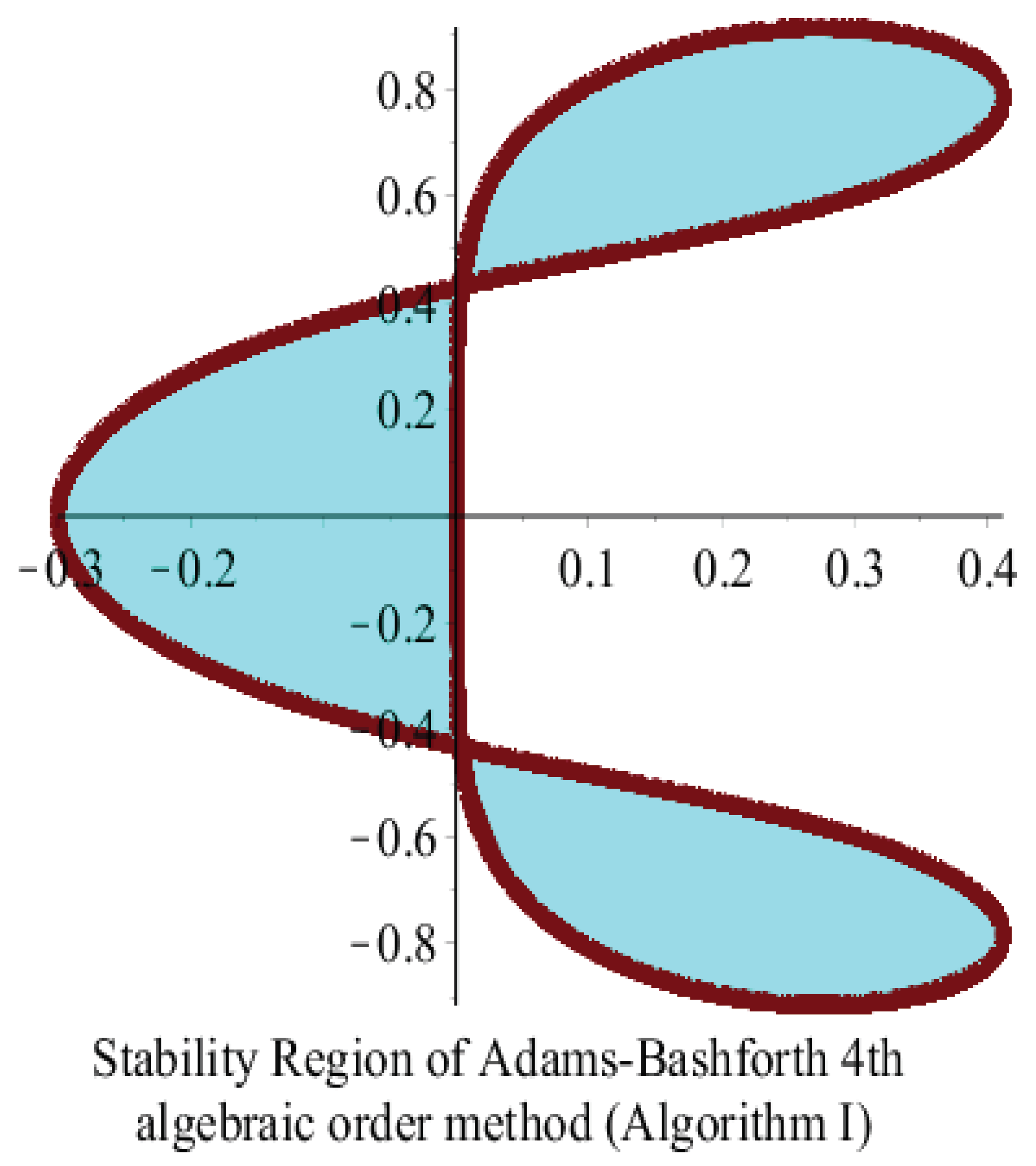
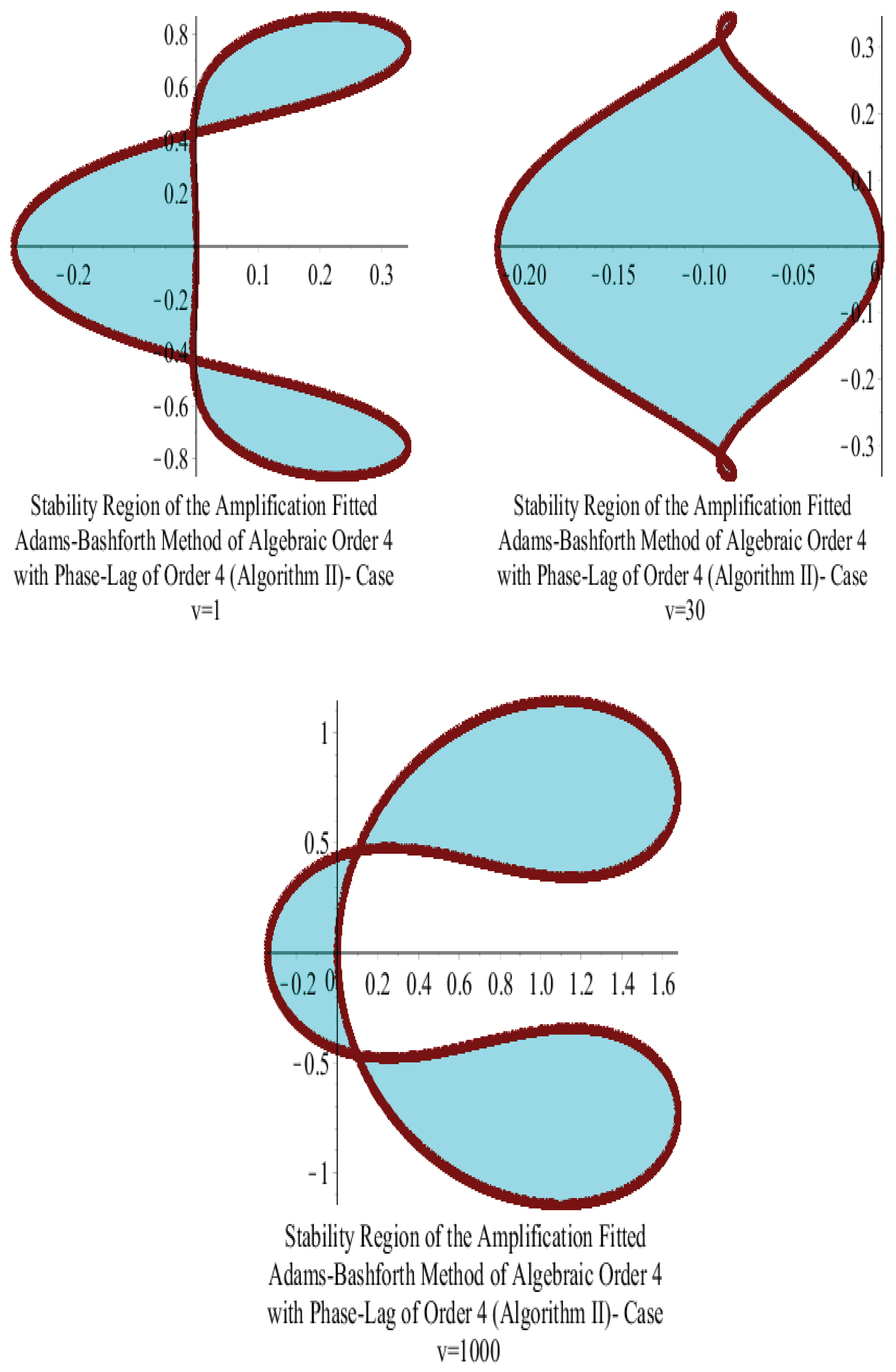

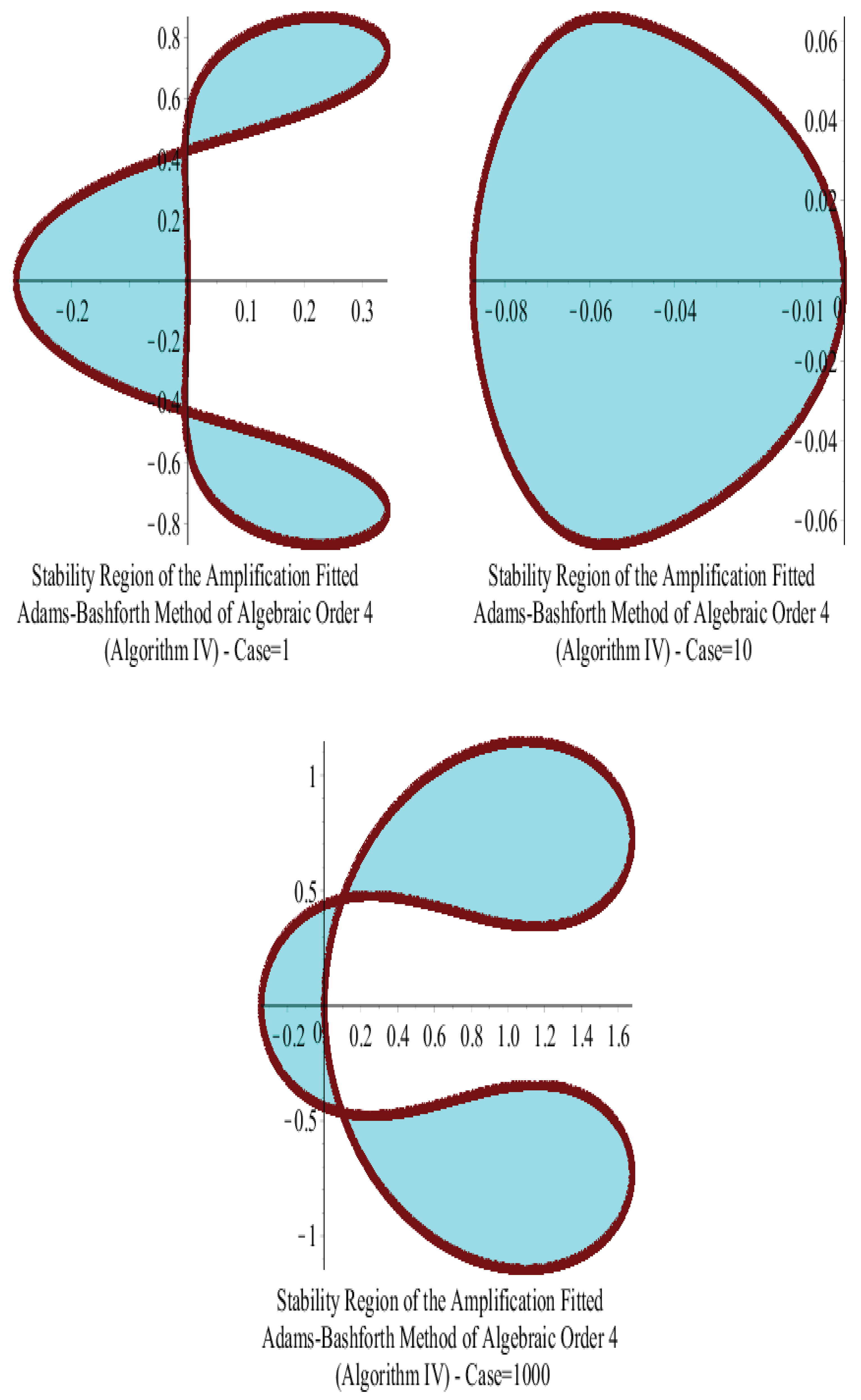
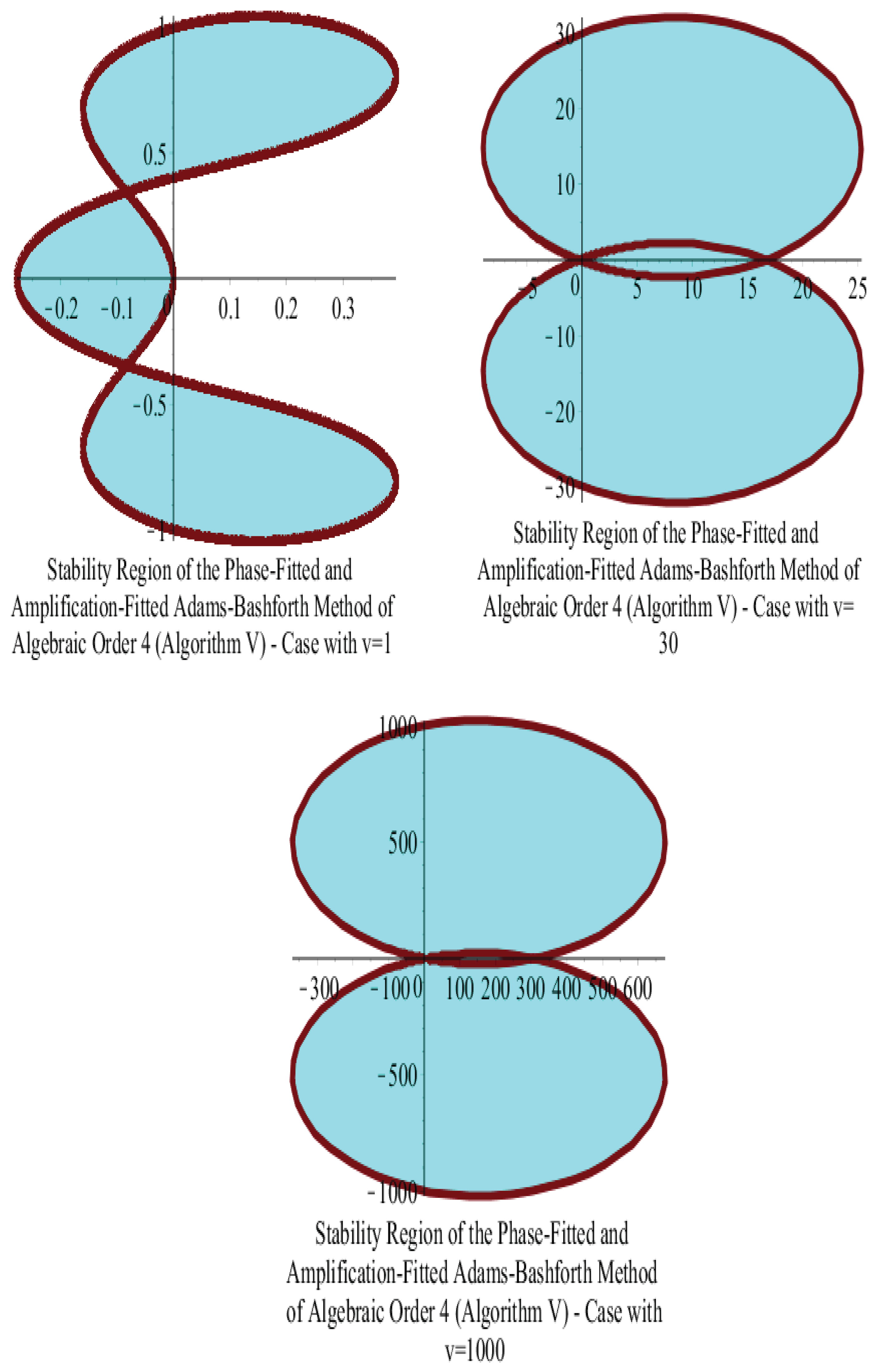
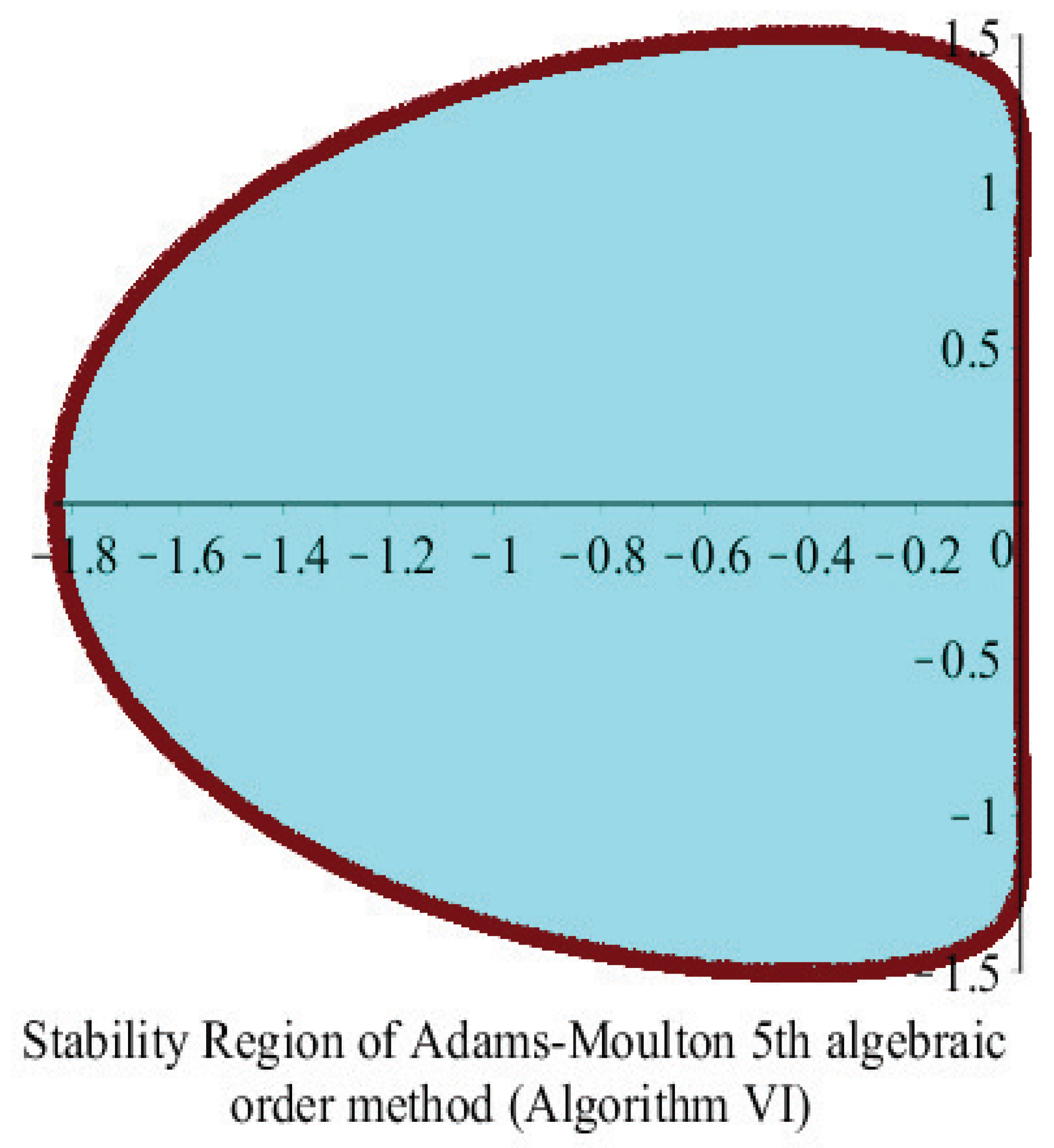
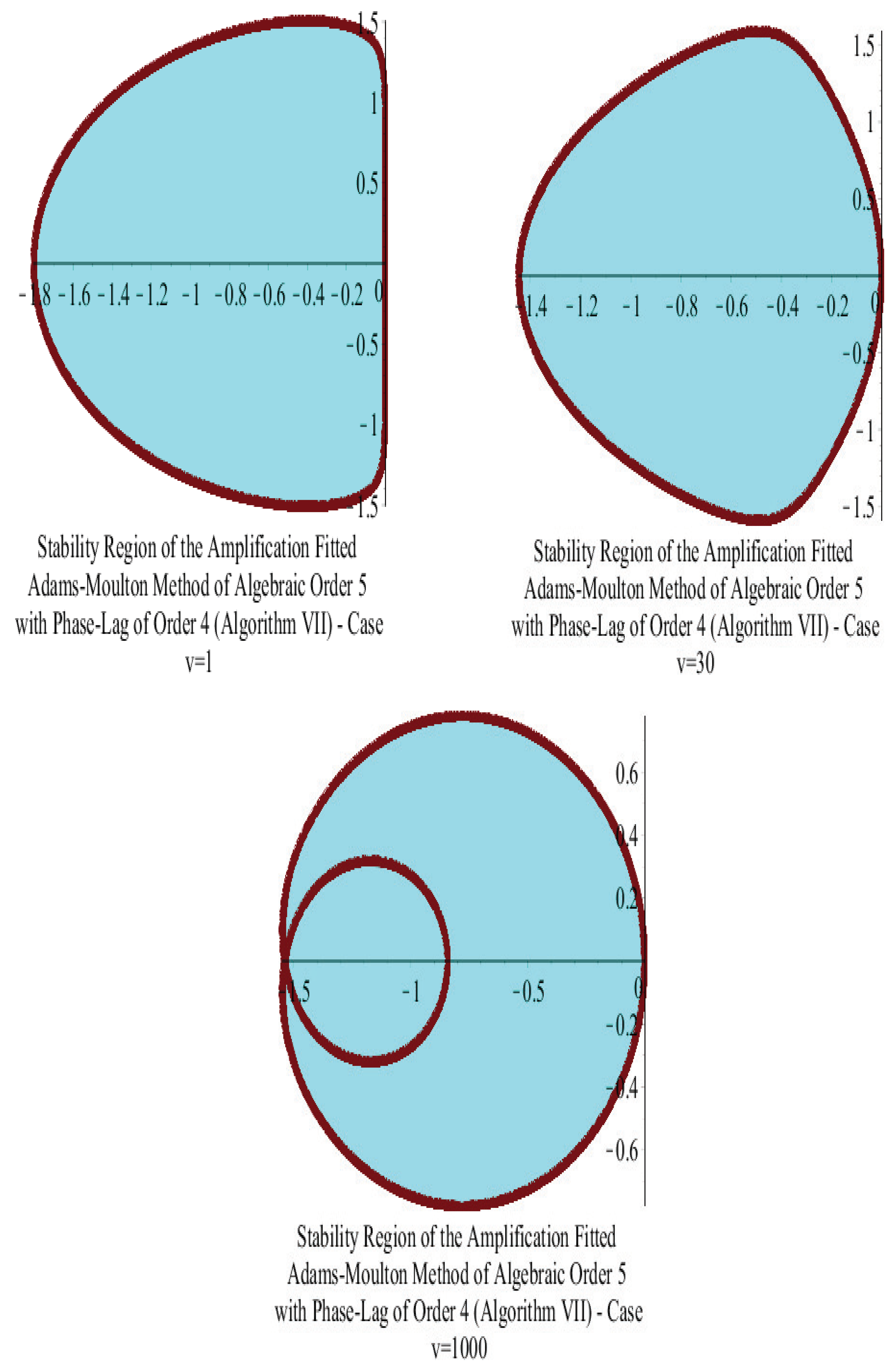
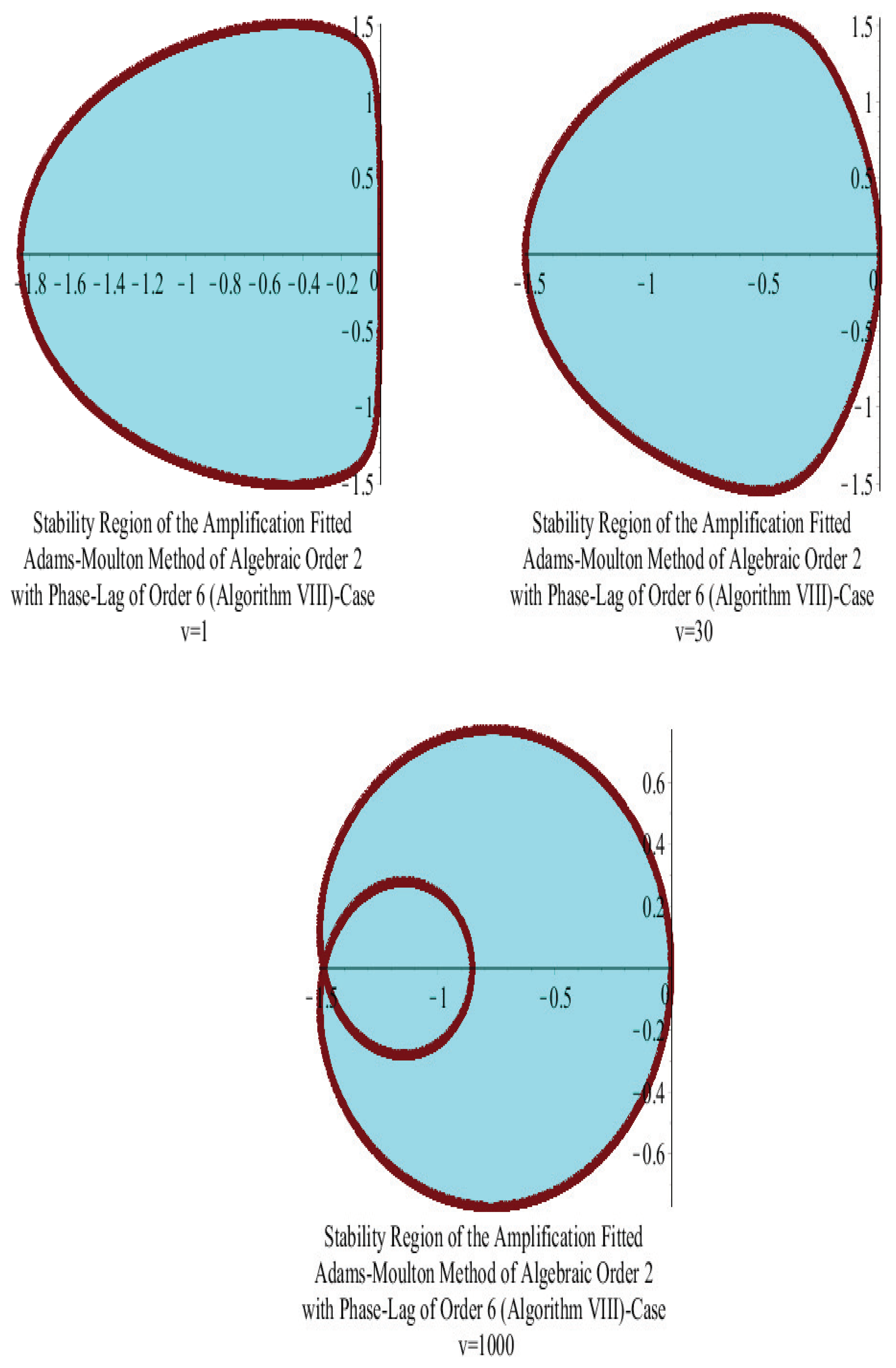
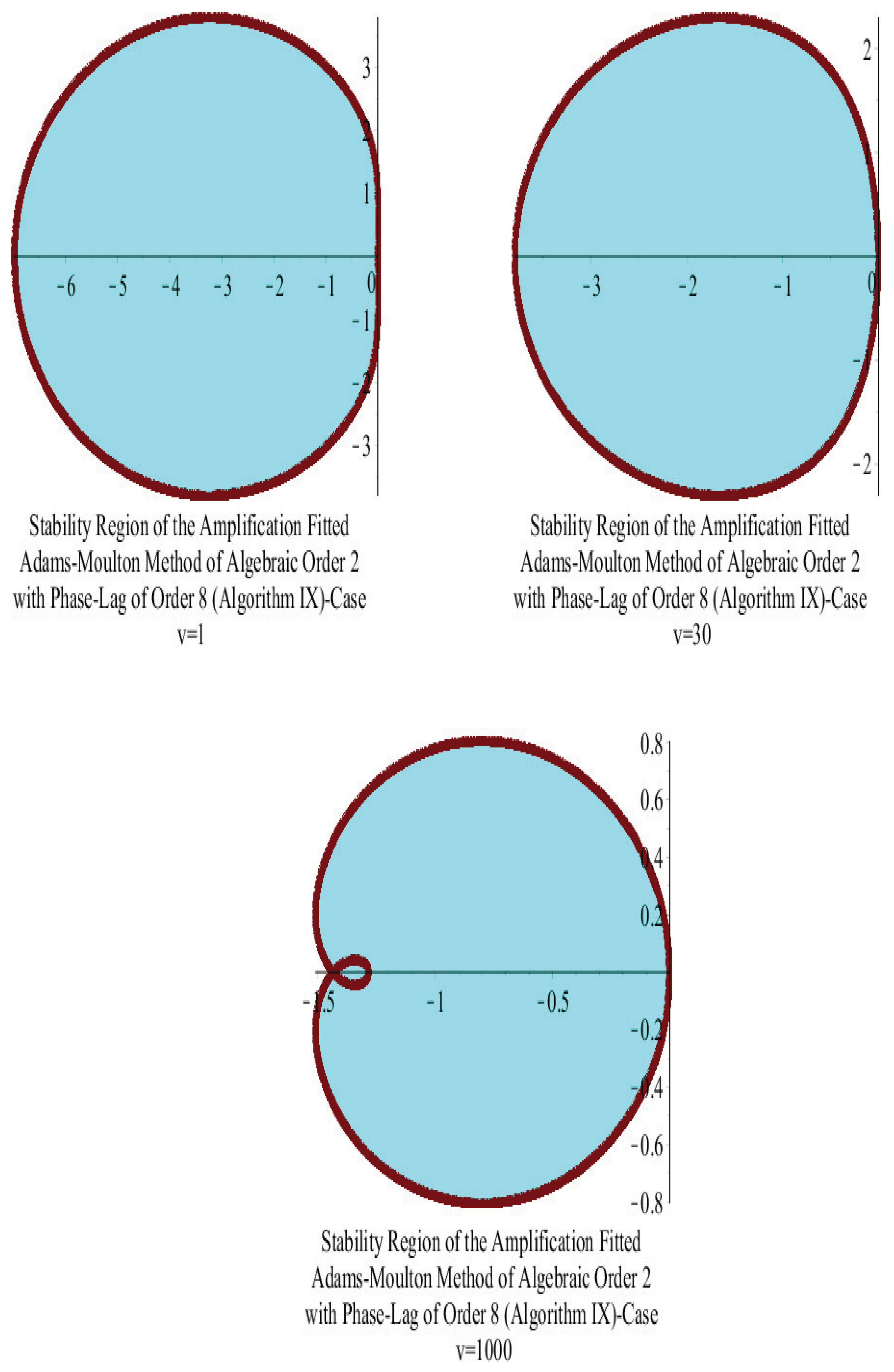
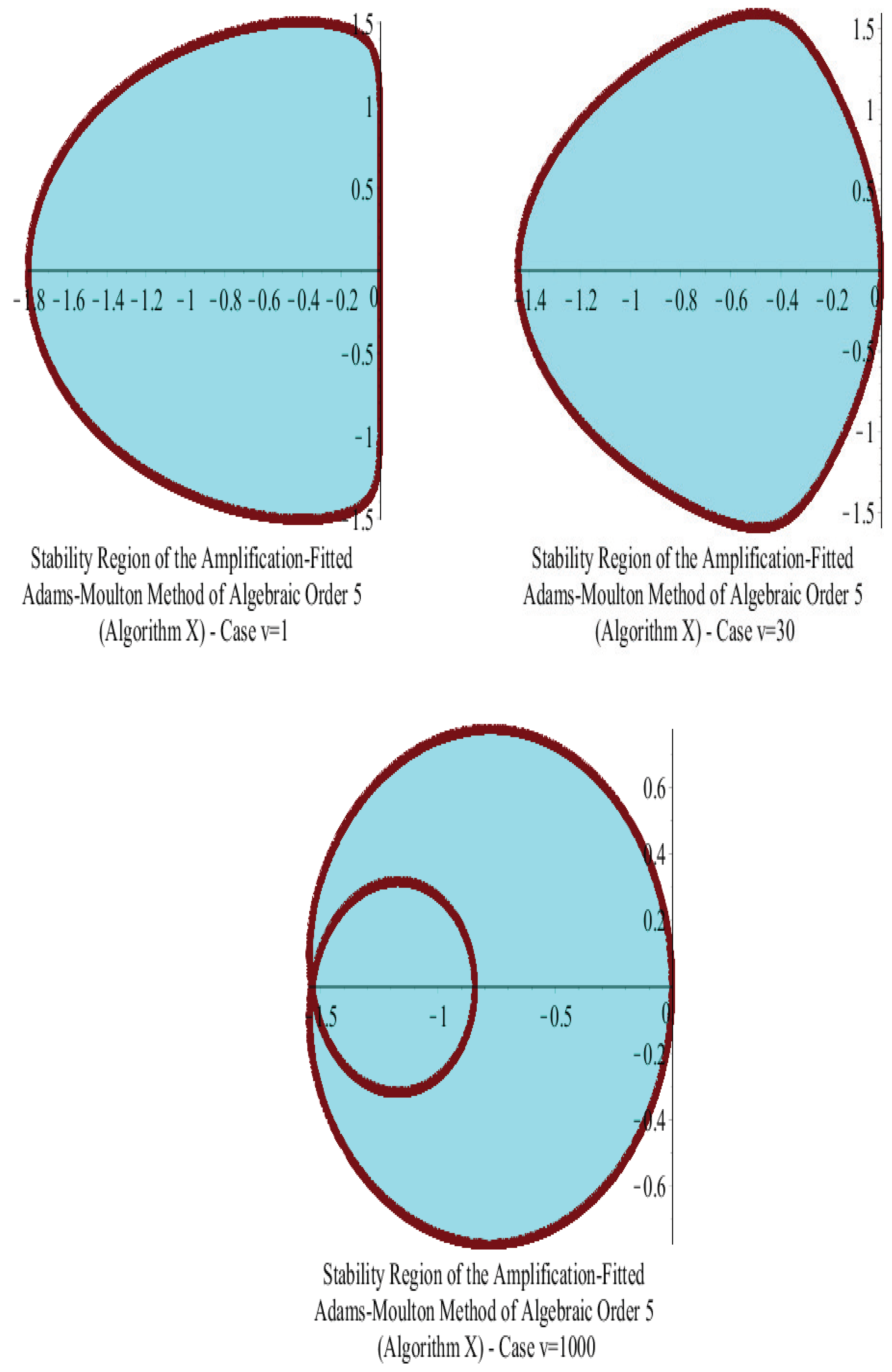
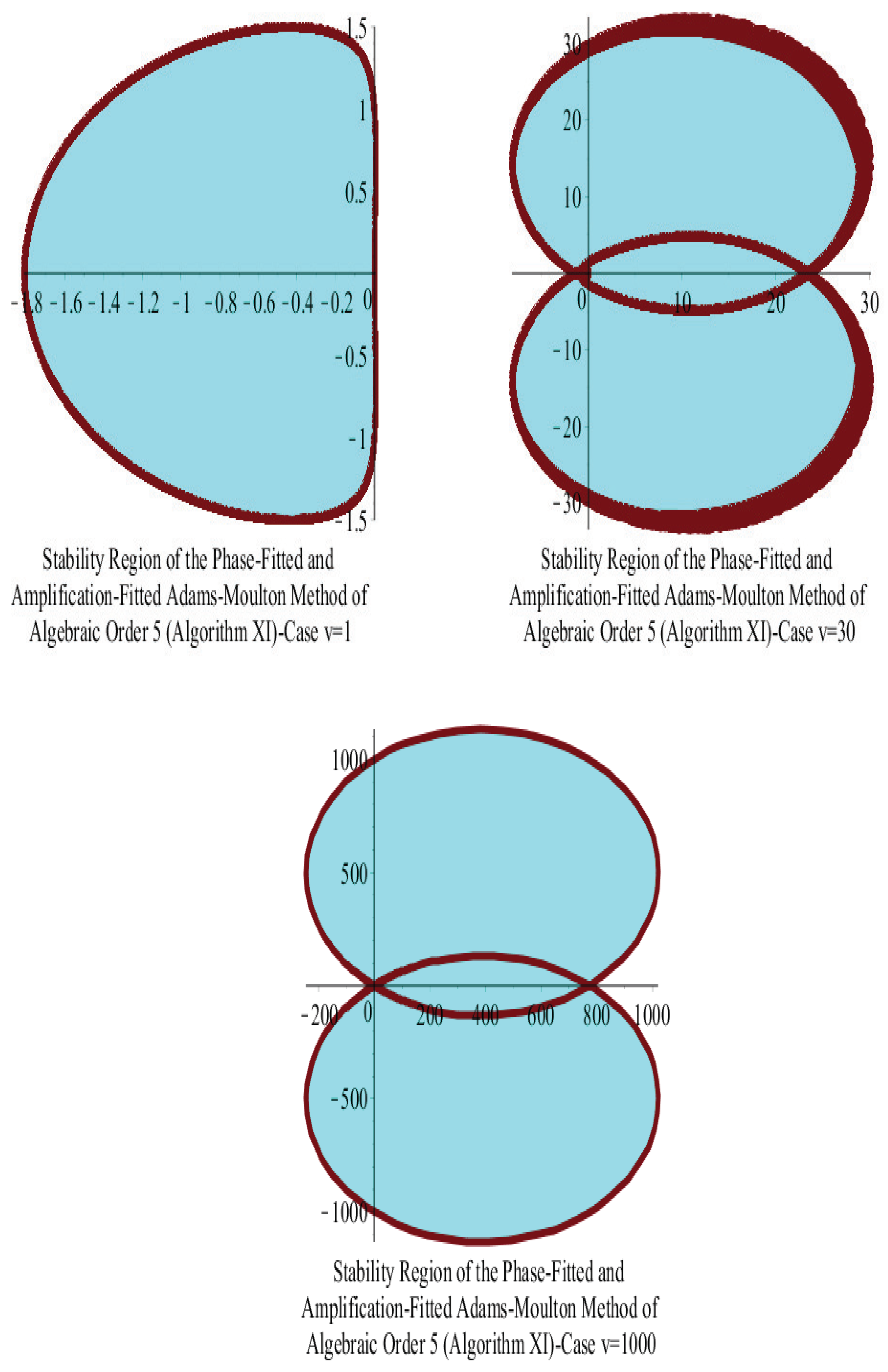
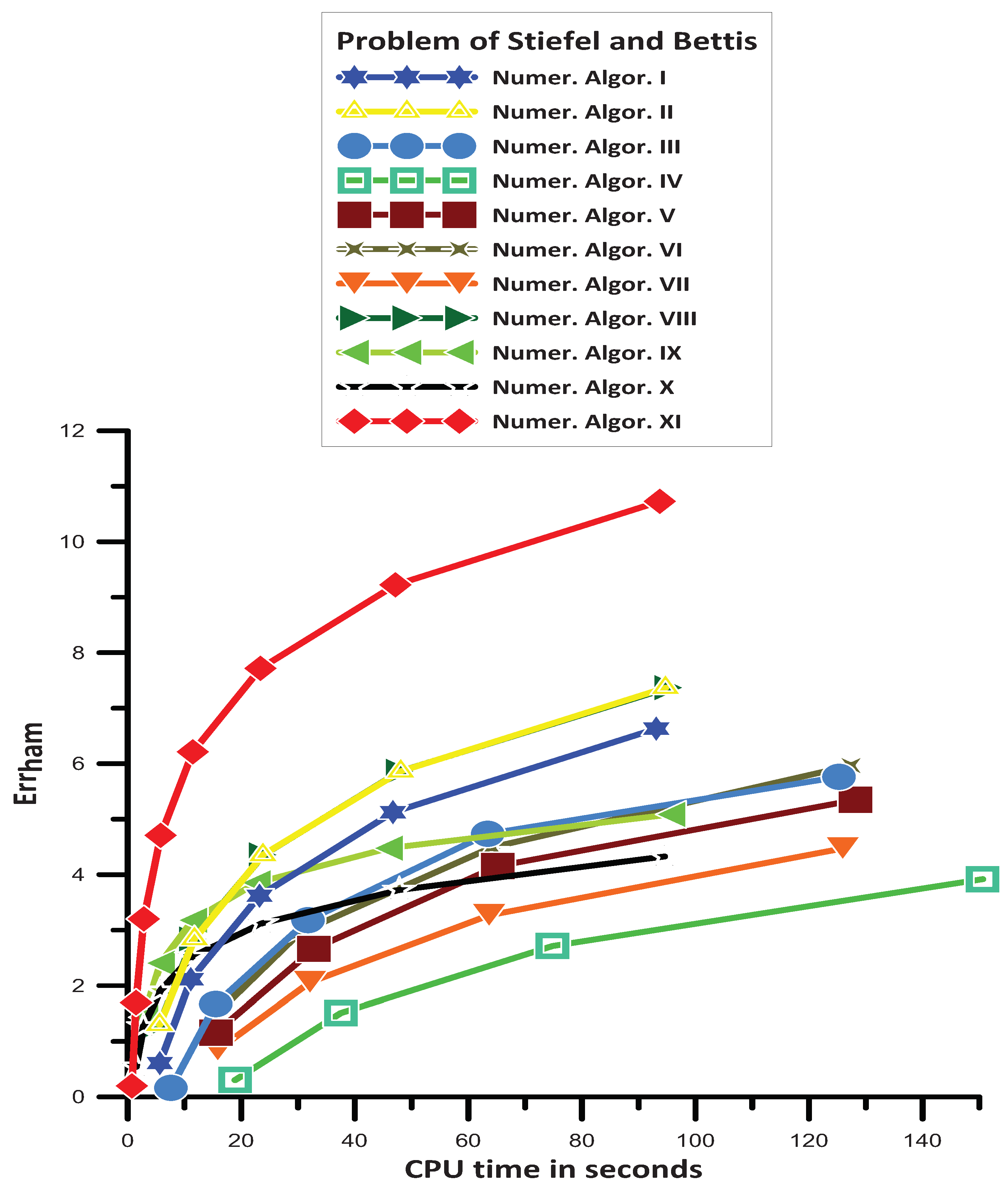
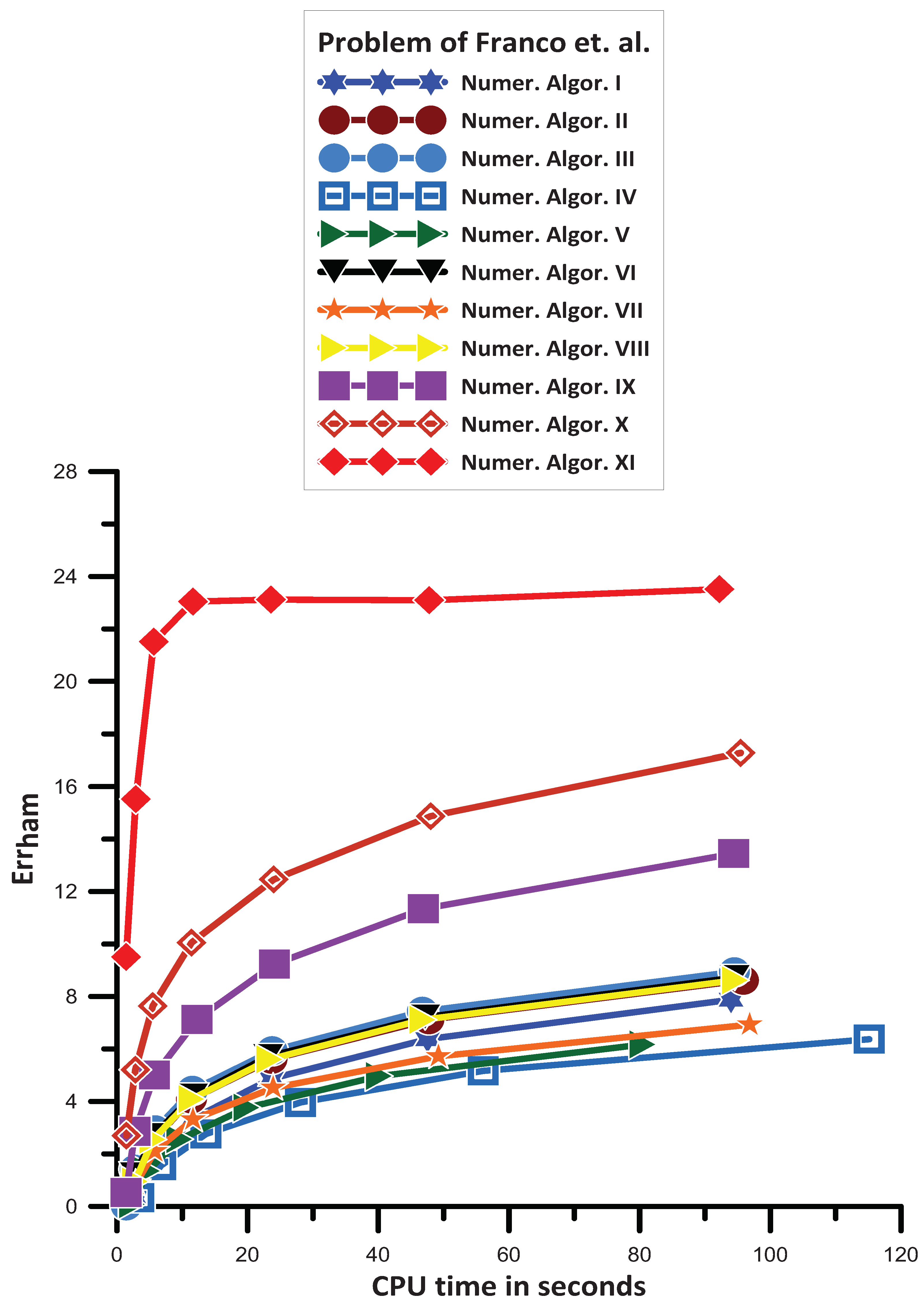
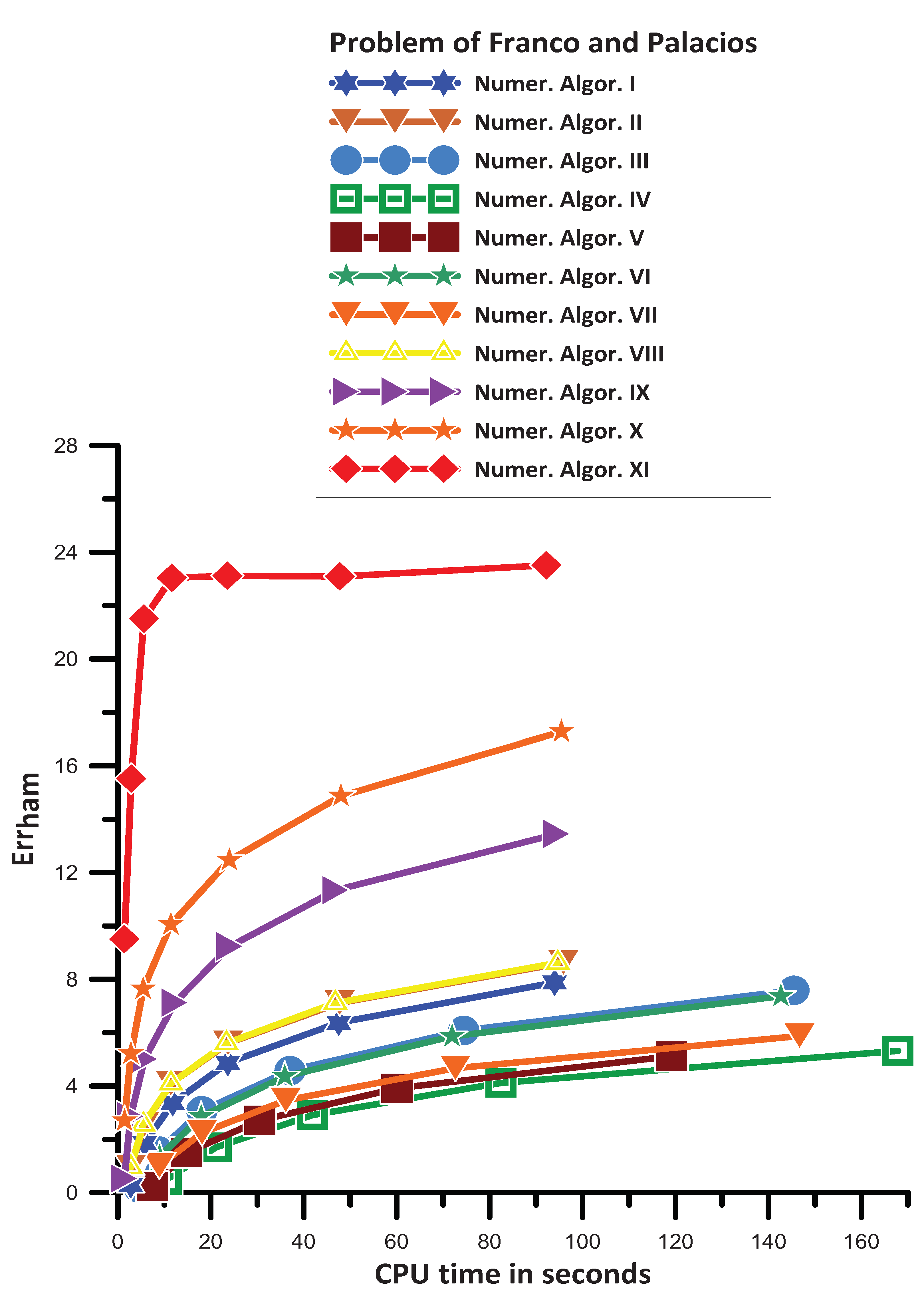


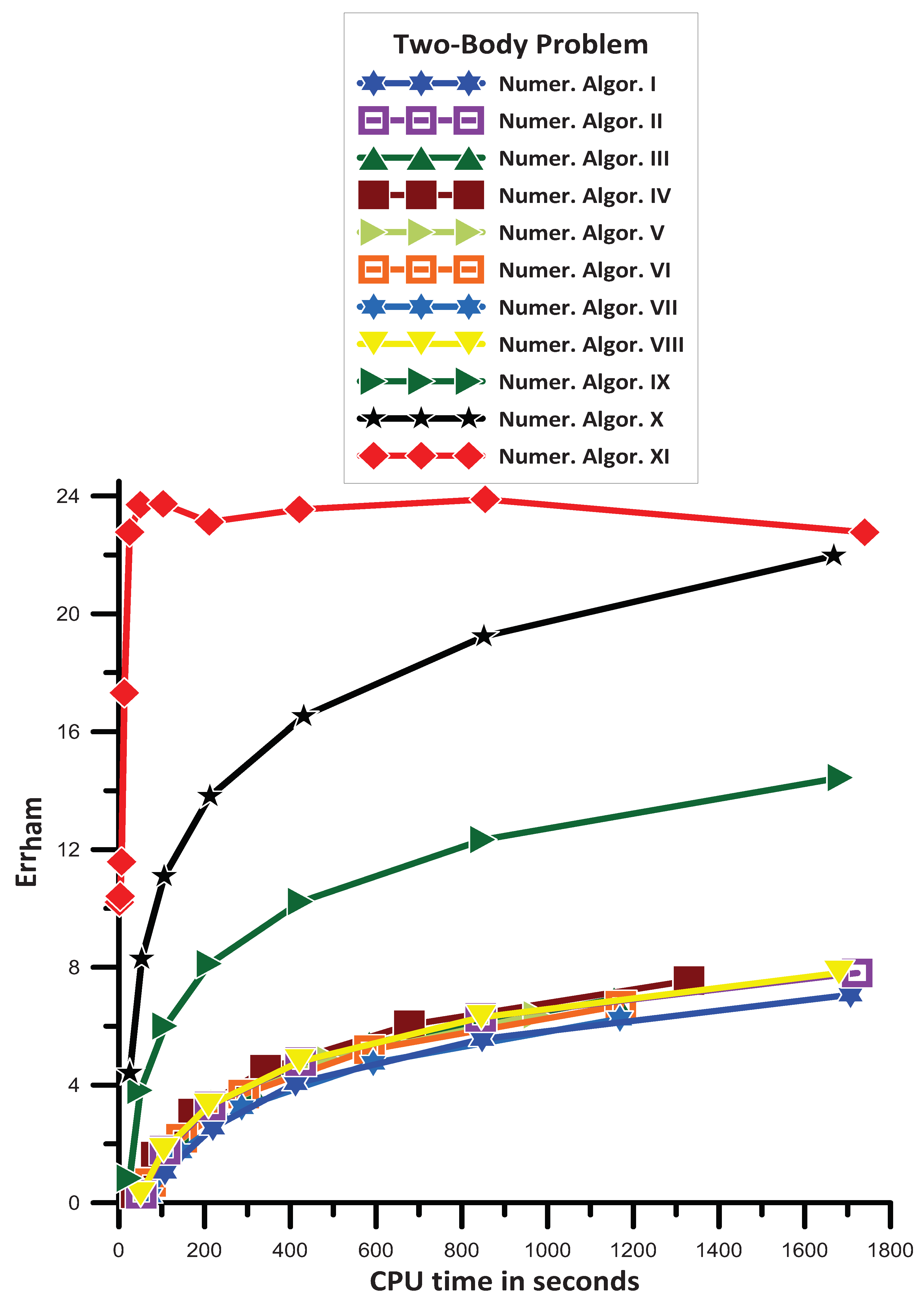
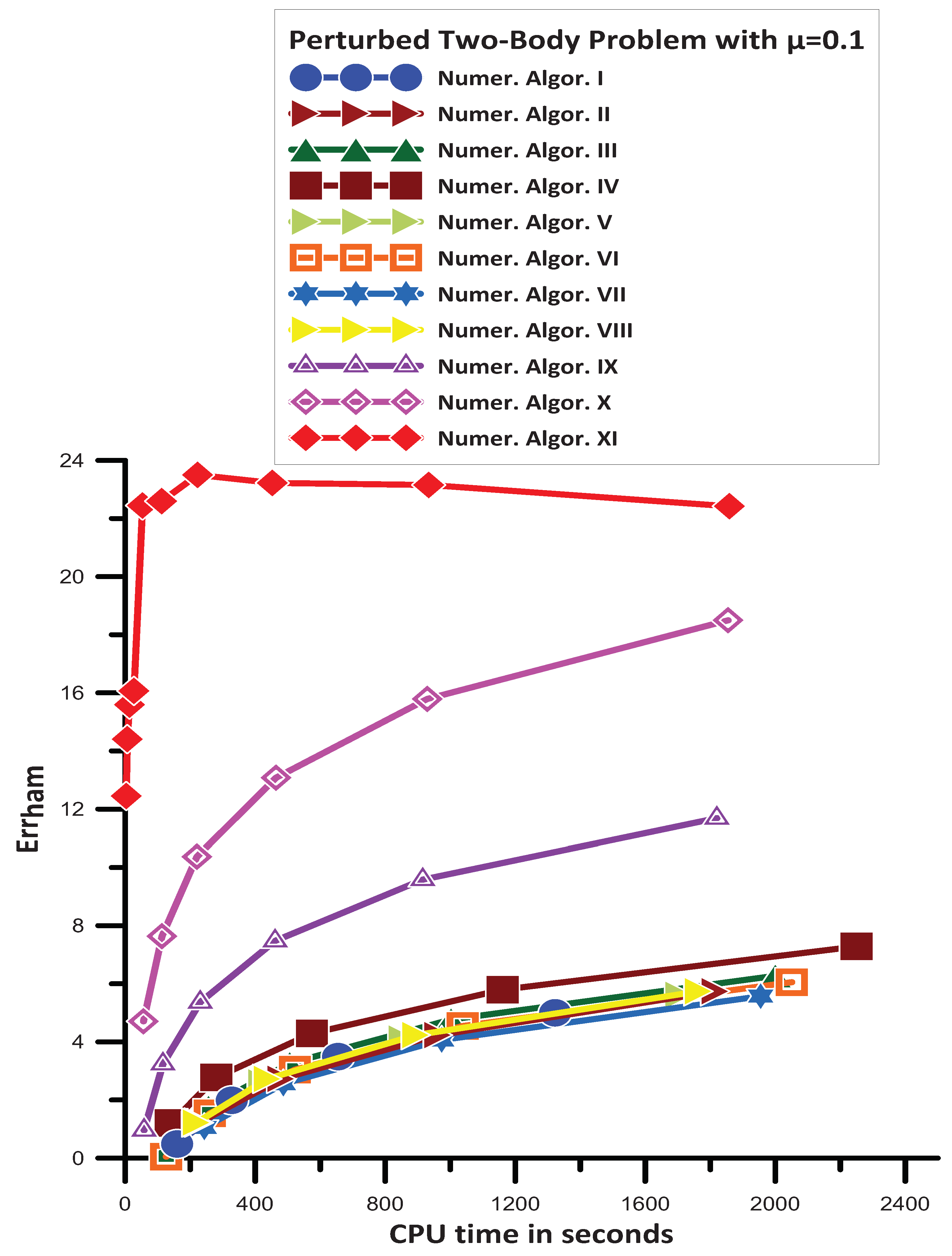
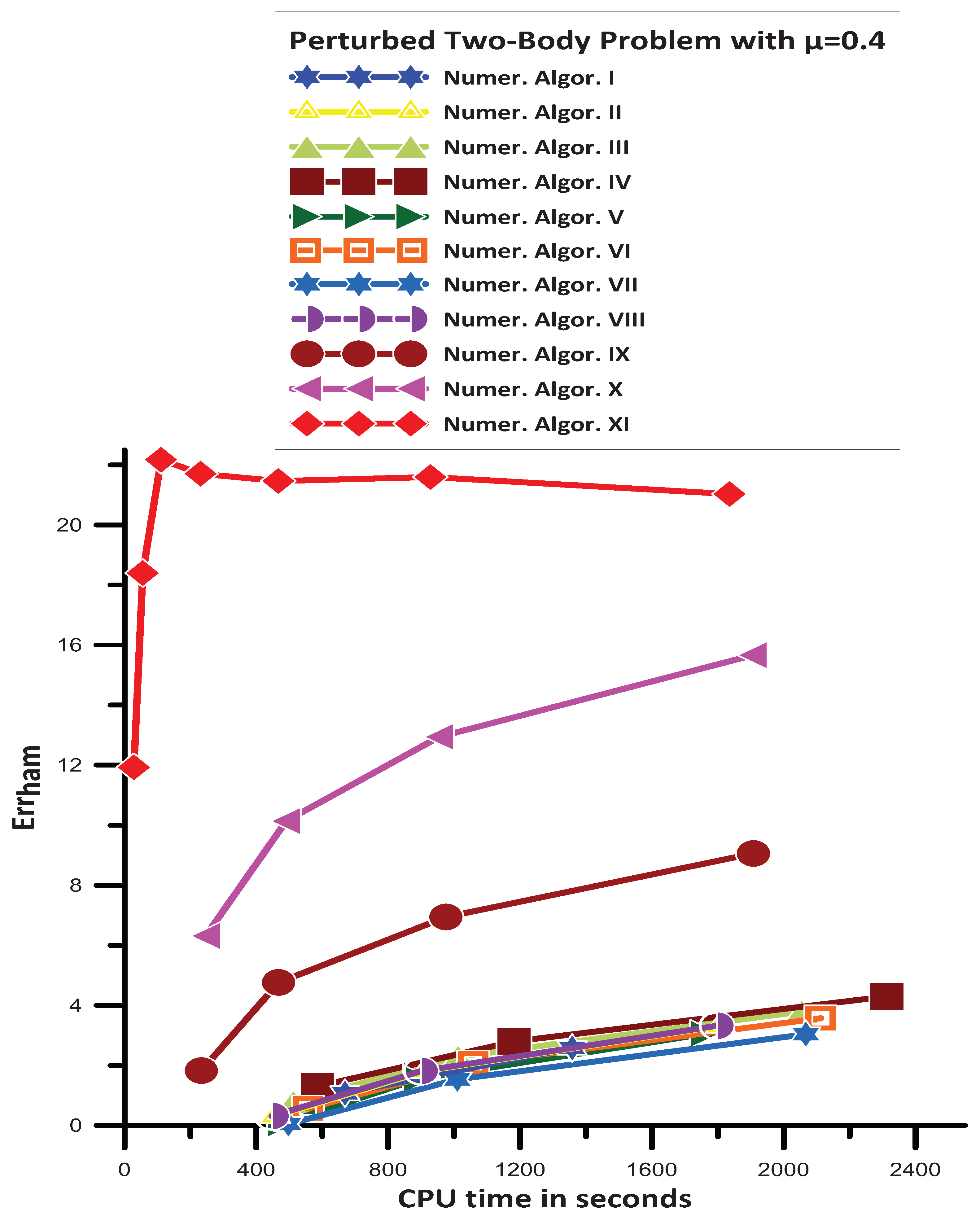
Disclaimer/Publisher’s Note: The statements, opinions and data contained in all publications are solely those of the individual author(s) and contributor(s) and not of MDPI and/or the editor(s). MDPI and/or the editor(s) disclaim responsibility for any injury to people or property resulting from any ideas, methods, instructions or products referred to in the content. |
© 2024 by the author. Licensee MDPI, Basel, Switzerland. This article is an open access article distributed under the terms and conditions of the Creative Commons Attribution (CC BY) license (https://creativecommons.org/licenses/by/4.0/).
Share and Cite
Simos, T.E. Efficient Multistep Algorithms for First-Order IVPs with Oscillating Solutions: II Implicit and Predictor–Corrector Algorithms. Symmetry 2024, 16, 508. https://doi.org/10.3390/sym16050508
Simos TE. Efficient Multistep Algorithms for First-Order IVPs with Oscillating Solutions: II Implicit and Predictor–Corrector Algorithms. Symmetry. 2024; 16(5):508. https://doi.org/10.3390/sym16050508
Chicago/Turabian StyleSimos, Theodore E. 2024. "Efficient Multistep Algorithms for First-Order IVPs with Oscillating Solutions: II Implicit and Predictor–Corrector Algorithms" Symmetry 16, no. 5: 508. https://doi.org/10.3390/sym16050508
APA StyleSimos, T. E. (2024). Efficient Multistep Algorithms for First-Order IVPs with Oscillating Solutions: II Implicit and Predictor–Corrector Algorithms. Symmetry, 16(5), 508. https://doi.org/10.3390/sym16050508





